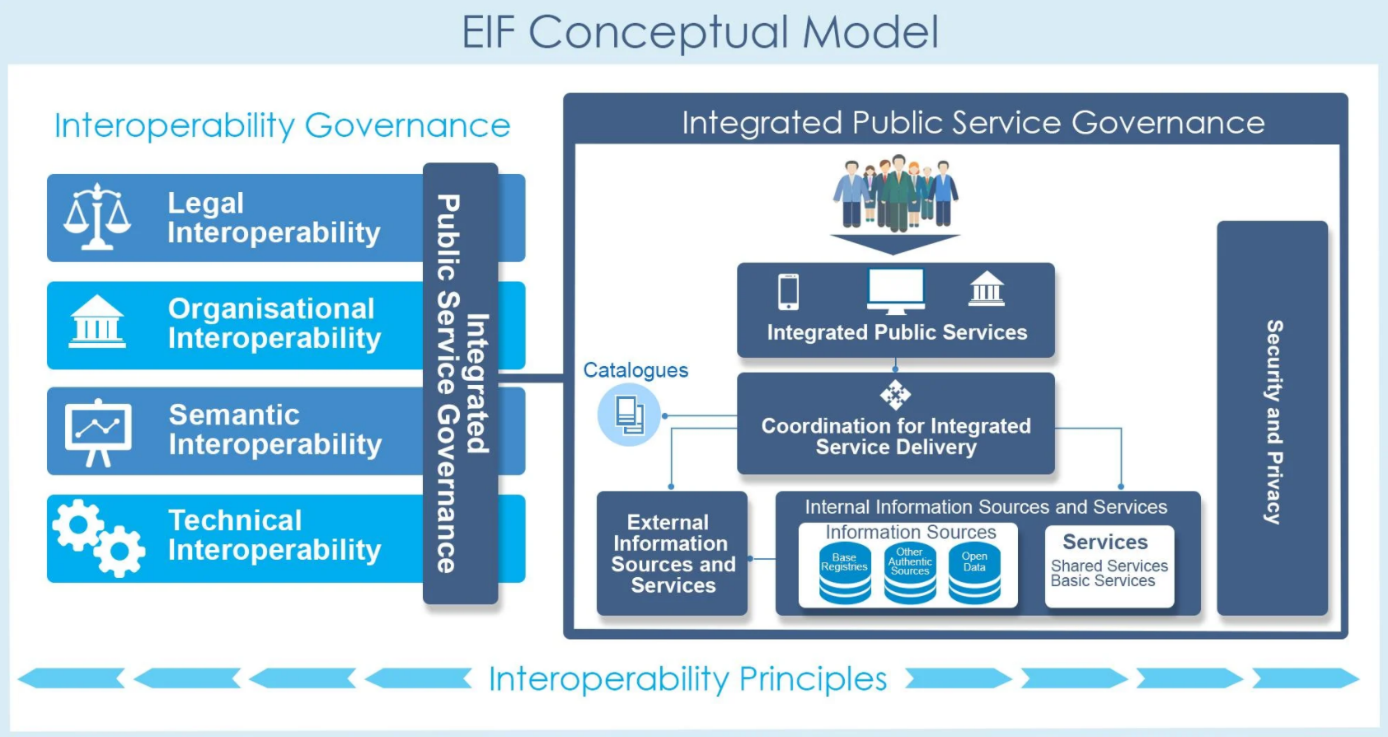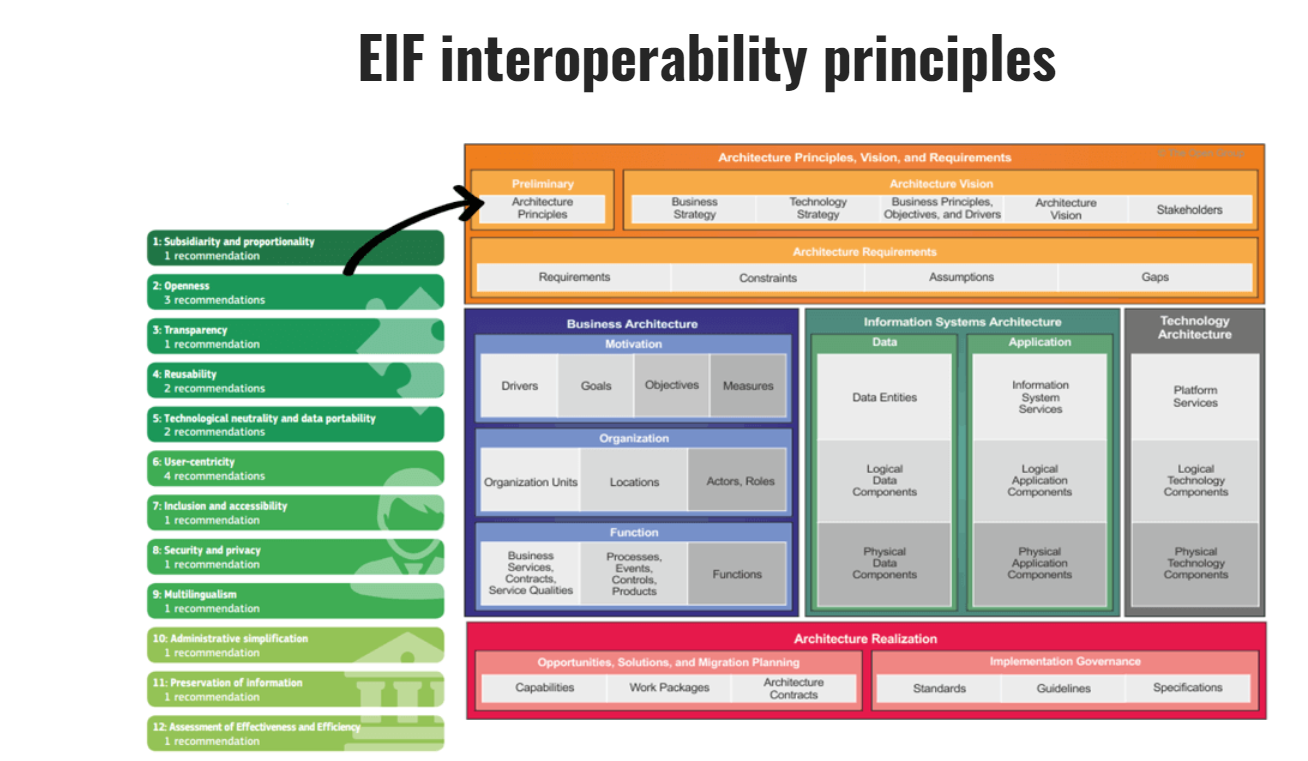The implementation of the European interoperability framework (EIF) is guided by the following vision: Provide businesses and citizens with key interoperable, user-centered digital public services that support the free movement of goods, persons, services and data.
In recent decades, European public administrations have invested in ICT (Information and Communications Technology) to modernize their internal operations, reduce costs and improve the services they provide to citizens and businesses. Despite significant progress and benefits already gained, administrations still face significant barriers to information exchange and electronic cooperation. These include regulatory barriers, incompatible business processes and information models, and the diversity of technologies used. This is because in the past, public sector information systems have been set up independently of each other and not coordinated. The diversity of institutional structures across Europe adds to the complexity at EU level.
Interoperability is a prerequisite for electronic communications and information exchange between public administrations. This is also a precondition for the creation of a digital single market. Interoperability programs in the EU have evolved over time. First, they dealt with achieving interoperability in certain areas, and then with the establishment of a common infrastructure. Recently, they have begun to address interoperability at the semantic level. Governance, compatibility of legal regimes, coordination of business processes and secure access to data sources are some of the issues that will be addressed below for the provision of full-fledged public services.
The EIF promotes electronic communication between European public administrations by providing a set of common models, principles and recommendations. It recognizes and emphasizes the fact that interoperability is not just an ICT issue, as it has various implications, from legal to technical. Addressing issues in an integrated approach in all these layers and at different administrative levels from local to EU remains a challenge. At the same time, the EIF identifies four layers of interoperability challenges (legal, organizational, semantic and technical) and recalls the essential role of governance in ensuring the coordination of relevant activities at all levels and in the administrative sectors.
The EIS (European Interoperability Strategy) conceptual model for public services covers the design, planning, development, operation and maintenance of integrated public services at all levels of government, from local to EU level. The principles set out here guide decision-making on the establishment of interoperable European public services. In addition, the EIF offers practical tools in the form of a set of recommendations that can be implemented.

General underlying principles of European public services are:
1. Subsidiarity and proportionality: Public administrations should align their interoperability frameworks with the European Interoperability Framework to take into account the European dimension of public service delivery.
2. User-centricity: Public services are intended to serve the needs of citizens and businesses.
3. Inclusion and accessibility: Public administrations should ensure that public services are accessible to all citizens, including persons with disabilities and the elderly, according to e-accessibility specifications widely recognised at European or international level.
4. Security and privacy: Public administrations should consider the specific needs of each European public service, within the context of a common security and privacy policy.
5. Multilingualism: Public administrations should use information systems and technical architectures that cater for multilingualism when establishing a European public service.
6. Administrative simplification: Businesses compile large amounts of information, often solely due to legal obligations, which is of no
direct benefit to them and not necessary for achieving the objectives of the legislation imposing the
obligations.
7. Transparency: Citizens and businesses should be able to understand administrative processes.
8. Preservation of information: Public administrations should formulate together a long-term preservation policy for electronic records relating to European public services.
9. Openness: Public administrations should aim for openness when working together to establish European public services, while taking into account their priorities and constraints.
10. Reusability: Public administrations are encouraged to reuse and share solutions and to cooperate on the development of joint solutions when implementing European public services.
11. Technological neutrality and adaptability: Public administrations should not impose any specific technological solution on
citizens, businesses and other administrations when establishing European public services.
12. Effectiveness and efficiency: Public administrations should ensure that solutions serve businesses and citizens in the most effective
and efficient way and provide the best value for taxpayer money.
The model promotes the reuse of information, concepts, patterns, solutions, and specifications in Member States and at European level, recognising that European public services which are based on information from various sources located at different levels of administration and combine basic public services constructed independently in particular service orientation and specific way of creating and using business processes, packaged as services, throughout their lifecycle.


0 Comments